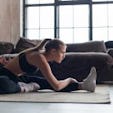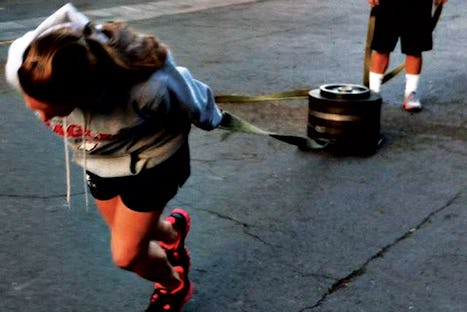
Athletes have some special needs, many of which could be addressed with these three fundamental types of exercises.
The needs of an athlete are fairly simple; they need to be agile, mobile, and hostile at the drop of a dime. Their bodies are placed under tremendous stresses day in and day out, posing challenges for any physical trainer. We must plan, prepare, and program many strategies to enable each individual to play at a peak level come game day.
What’s Special About Training for Athletes?
Unlike a typical person training for a road race or weekend pick-up game, athletes require a template which consists of three different seasons: Pre-, Post-, and In-Season training. A coach must vary exercises, volume, and the amount of weight being used in each season. You can see that this will challenge a Strength Coach who must also allow for down time, rehab, and growth.
There are three main exercises we focus on programming into our protocol: Plyometrics, (Upper / Lower), Carries (Farmers, Overheads, Un-even), and Sleds (Pushing / Pulling / Overload).
Why are these three fundamentals programmed in for our athletes? Because we can train the whole body to be explosive and powerful by performing these exercises year round. As a coach, I need the most bang for my buck with every rep, set, and exercise. These three allow me to achieve that while consistently tracking the athletes’ progress each season.
Fundamental Athlete Exercise #1 | Plyometrics
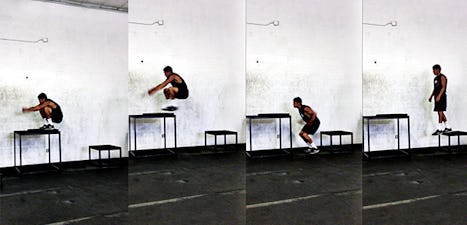 Let’s start by digging a little deeper into each category, starting with Plyometrics. The father of plyos is Dr. Yuri Verkoshansky. He developed the shock method which is based on a type of reaction jump, such as a depth jump (dropping off a low box and immediately jumping onto a larger box). This can also be exemplified by hurdle jumps (bounding over consecutive heights). It forces the muscles to fire off quickly for a fast response.
Let’s start by digging a little deeper into each category, starting with Plyometrics. The father of plyos is Dr. Yuri Verkoshansky. He developed the shock method which is based on a type of reaction jump, such as a depth jump (dropping off a low box and immediately jumping onto a larger box). This can also be exemplified by hurdle jumps (bounding over consecutive heights). It forces the muscles to fire off quickly for a fast response.
We want to decrease ground contact time while increasing the amount of pressure and force you are applying. Two leg and single leg bounding up stairs or across a field are great exercises to develop Rate of Force Development (ROFD). Basically, this is referring to the speed at which force can be produced. If speed, power, and explosiveness is what you are after, then plyos are a tremendous benefit for any athlete.
Upper body plyometrics include Push Ups with any type of hand release from the ground, as well as bounding from a height to the ground and then back up again. You can use varying heights or just change your hand position from close to wide or alternate front to back. This will help athletes who play in any contact sport become better equipped to transition from a deceleration phase to an accelerated one.
This type of training increases the explosive power in the lower and upper body which is required for almost every sport. If you train athletes in this manner, they will have an extreme advantage over their counterparts.
One of the best ways to pack on some muscle is to pick up any object and carry it for a set distance, the longer the better! It will tax your whole system to force growth from your head to your toes (yes, literally). When carrying objects, the first thing that is tested is your grip (hand strength). I firmly believe that grip strength is imperative to all athletes.
Fundamental Athlete Exercise #2 | Carries
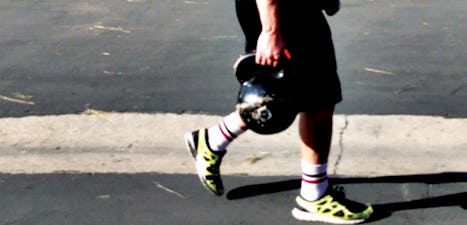 Farmer Walks of all varieties can create great confidence in an athlete. They will be able to move more weight for a longer distance in a very short amount of time. The best part about this exercise is that it doesn’t matter what you pick up; everything works to make you STRONGer! We use Dumbbells, Kettlebells, Sandbags and Kegs; pretty much anything you can find will work. The implement is not the main focus, it’s the ability to carry more and more every session for a longer time period that is.
Farmer Walks of all varieties can create great confidence in an athlete. They will be able to move more weight for a longer distance in a very short amount of time. The best part about this exercise is that it doesn’t matter what you pick up; everything works to make you STRONGer! We use Dumbbells, Kettlebells, Sandbags and Kegs; pretty much anything you can find will work. The implement is not the main focus, it’s the ability to carry more and more every session for a longer time period that is.
This exercise also helps build strength for other exercises such as the Squat and Deadlift. We give the same coaching cues when picking up and placing down weights that we would use during any weight room lifts (head neutral, flat back, drive thru the ankles, etc.). This allows us to reinforce proper technique while taking a very strenuous exercise outdoors. Making the training fun and taking it out of the weight room helps the athlete push through self-imposed limits.
When performing carries of two objects, you don’t need to use the same weight in each hand. That’s one of the great things about performing them. You can even use two different objects altogether. Also, to increase the difficulty of the exercise on the Central Nervous System (CNS) without adding any weight to their grip, you can have them wear a weighted vest or heavy chains. It loads the spine and the legs without taxing the grip so they can perform more sets.
Another way we use the carries to help increase shoulder stability and core strength is to perform overhead carries. Again, you can carry one or two objects and use different weights. An easy version would be to use a sandbag that is not very heavy. A difficult version would be to use a half filled keg. The keg poses increased stress on the core and shoulders due to the liquid sloshing around. It will never settles so your muscles will be working overtime.
Fundamental Athlete Exercise #3 | Sleds
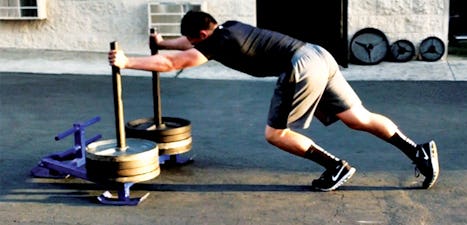 This brings us to our final must have exercise for athletes: SLED pulls, pushes, and drags!
This brings us to our final must have exercise for athletes: SLED pulls, pushes, and drags!
What makes this one of the best training tools is the variety of the movements and the strength it develops. We can change the load, angles, and volume to elicit many different training modes to develop speed, conditioning, and strength year round.
Sled drags can be performed in many different variations with and without using your upper body for stabilization. They can be used to be dragged forward, backward, laterally, and with a belt for running mechanics. The spine is not loaded so we save the CNS from being over taxed while still building the entire body.
Let’s say we want to develop speed as we edge closer to a new season. We can cut our weight to 40-60% of what you would use on a heavy day and make the movement much faster. This way you get proper shin angle and enough hip drive to make it a complete speed training session.
With an in-season session we would like to maintain the gains achieved through all the training from the months prior, but we don’t want to tax the body with a large amount of load or volume due to the increase in sport specific training. Programming would reduce the weight to 75-85% of max load and less volume/distance. This allows for longer rest periods so you can maintain strength and the prior gains made.
If you are in the off-season, you can choose to overload a sled with maximal weight so you must struggle to accomplish the required distance. In doing this, it forces you to mentally challenge yourself to overcome physical limitations. So, not only are we building the body, but also self-confidence and mental strength! This may just be the greatest after effect of all training¦
The greatest advantage to using a sled is they can be used on maximal, volume, and recovery days. Plus, sometimes you can improvise and not even use a metal sled; plenty of people have developed lower cost sled type tools such as tires, reinforced pallets, or plastic materials. The king of all sleds is sitting right in our own garage. On a flat surface, a car or truck can be utilized to condition any athlete; just make sure you have a competent navigator to help.
Conclusion
Coaching with a proper program, hard work, and dedication can build some indestructible athletes. Remember K.I.S.S. (keep it simple stupid). Don’t over complicate the process; the weight room is a facilitator to movement. We are teaching athletes to move efficiently so they can transfer that ability to the field.
I hope this helped shed some light on how simple tools and methods can be turned into maximum gains in strength for athletes. Bigger-Faster-STRONGer!
Mike Rojas is the Owner and Head Strength & Performance Coach of Strong 101 Gym in Norco, CA. His coaching has helped produce numerous Div. 1 athletes in multiple sports. The success of Strong 101 is based around proper programming coupled with efficient technique and movement. This has helped make Strong 101 the #1 athlete training facility in the Inland Empire.

)

